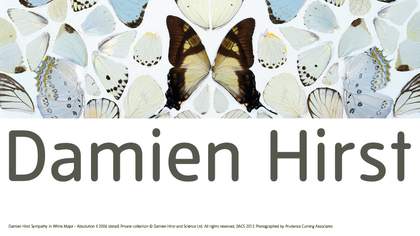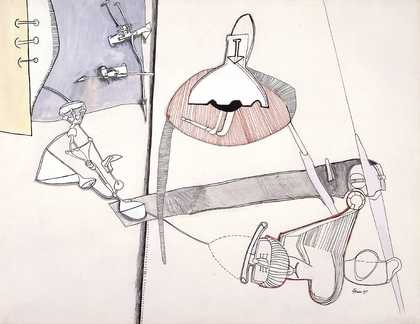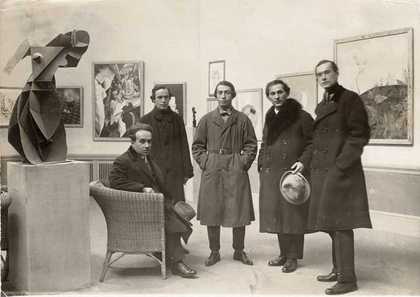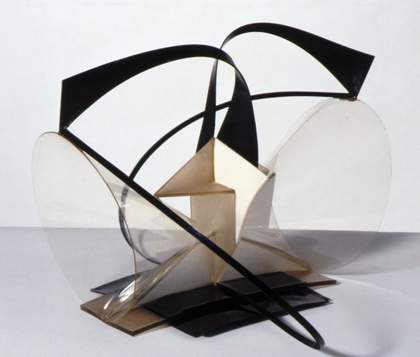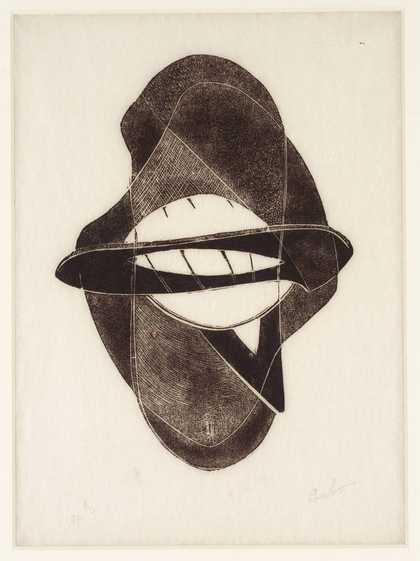It was on 5 June that, in the Magenta-Sempione zone, innumerable objects and supplies of plastic materials, especially those made of ‘lurone’, began to rise and expand. In this case, the process was slow. The handle of a common table knife has taken a week to assume a diameter of ten centimetres. At first, there was only amazement and hilarity, then uneasiness and fright. Today, terror is unleashed.
Dino Buzzati, ‘Elephantiasis’, Le Notti difficili, Milan 19711
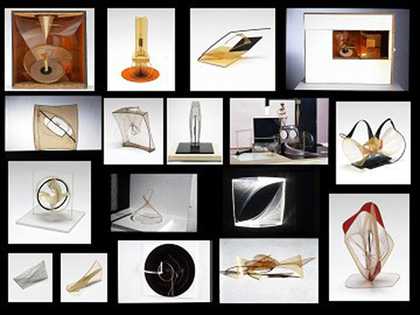
Fig.1
The works of Naum Gabo
© Nina Williams
Soon after the opening of Tate Modern in 2000, a fragment broke off a work by Naum Gabo, Spiral Theme 1941, in one of our displays. Though this has yet to unleash terror, it was, as far as I was concerned, a spontaneous and unexpected action certainly raising amazement and unease. However, from talking with colleagues in conservation, it appeared that the various plastics of which the sculpture is composed were pulling against each other, and the most fragile gave way. This was far from being an isolated incident as the cellulose plastics that Gabo employed had come to be recognised as unstable. The pristine qualities in plastic that Gabo favoured for its implications of modernity seemed on the point of being inverted in a way envisaged in Buzzati’s short story written in 1971 but set, prophetically, in 2007.
We now know that Gabo had used materials that he believed (initially, at least) to be entirely stable but that contained, in the measured, but nevertheless dramatic, language of conservation an ‘inherent vice’. Now the qualifiers required by such a description of what we believe to be the artist’s position reveal a number of things. Gabo’s particular use of materials reflected his interest in transparency, in describing space, and in capturing the third dimension through insubstantial linear forms. He saw plastics as a malleable equivalent to glass, but it also seems – though research continues – that he did not make particular choices about the plastics used. Over time he was willing, for instance, to replace elements in newer plastics available since he originally made the work. Despite this, it has seemed reasonable to conclude that his approach was to use the plastics available to him either unaware of their eventual chemical instability or setting that problem aside because it was not apparent either immediately or within the period close to the completion of his work.
Following in his footsteps, though bound by the problems of responding to their material conditions, conservators at Tate (and, of course, elsewhere) have been seeking ways of addressing this disintegration that is now only too clearly foreseeable. The piece-by-piece collapse of sculptures makes it possible that we may soon be able to calculate the time limit on Gabo’s work, which will then only be recuperable through photographs. The prospect for the artist and, of course, for the museum, is that the body of plastic sculptures that formed his crucial contribution to international constructivism in the 1930s and 1940s will imminently be lost.
It did not take a great deal of imagination to grasp that Gabo was not alone in having experimented with plastics that are now unstable and that this particular problem touches upon many other artists of his generation. László Moholy-Nagy used the same sort of plastics and, once alert to the signs, it is evident that certain of his sculptures are beginning to warp in a way familiar from the movements shown by Gabo’s sculptures. Immediately, further artists sprang to mind. There was also the collective realisation that there were conservators and curators across the world dealing with these problems in an ad hoc way and that, at the very least, it would be useful to bring this thinking together in order to try to understand what can be done, what should be done, but also what aesthetic, ethical and legal issues might arise from any action. Some guidance in these matters was provided by the example of Eva Hesse, whose work, though in different materials and with concerns of a different generation, nevertheless laid out the debate.
All of these examples, and others, raised the prospect of replicas. It was striking that the case of Hesse seems to have been a rare example where art historians and curators took on what had been identified as a pressing problem for conservators, and where disintegration might be met with the potential solution of replication. The questions aired in relation to Hesse could similarly be related to Gabo. Is it morally defensible to make replicas, or should the work be allowed to die gracefully? Is it something that should be countenanced as part of museum practice, or limited to museum practice? Does the desire to replicate reflect particular attitudes that prevail now, ranging from a nostalgia for the pristine in modernism to the commodification of art? Are there common principles that can be identified in relation to these concerns, or does each artist, each artwork, require a case-by-case solution? Are there broadly generational differences in attitude that would guide decisions, from unforeseen disintegration to embracing the ephemeral and transient?
As we began to extend these issues and debate these questions within our project and with the invaluable help of the Steering Committee invited to shape this workshop, many more questions arose. Some of these may be brought together in relation to the tensions arising between the artist, the object and the museum.
It was clear, for instance, that the problems are posthumous, as any disintegration within an artist’s lifetime – Damien Hirst comes to mind – is habitually (and, indeed, legally) referred back to the artist. The problems arise in relation to the interpretation of intentionality and its significance, the shifting attitudes within the artist’s intentions as and when they were recorded. It is possible to cite artists (Dieter Roth, for instance) who declared themselves in favour of embracing the ravages of time. But it is equally possible to imagine those who, for whatever reason, change their views with posterity in mind. Critical in this mixture, therefore, is how intentionality is handed on to and understood by assistants, estates and copyright holders, and to what extent the intention, insofar as it is identifiable and verifiable, is protected in the face of the dramatic collapse of the artwork.
Each object appears to raise its own specific problems. Current technology allows us to make replicas to a high degree of precision, so it remains in the process of decision-making about practice, rather than the practice itself, that the imponderables arise. If the material can be replaced in a way that is imperceptible, what degree of interpretation is acceptable? What state does one replicate: the state in which it left the studio (which may only be a subject of speculation), the state in which it was first photographed, or the state in which it was accurately recorded (in a museum this would often be on the point of acquisition)? Gabo is not the only artist for whom it is possible to imagine that these dates could lie very far apart and could yield very different objects.
Associated with this ability to make replicas and the accumulation of experience is the question of making unrealised works. If the artist had met material problems that could be easily surmounted by subsequent technology, it might be argued that the unrealised projects are closely related to those works subject to unforeseen disintegration. Perhaps both routes – replication of works and reconstruction of unrealised pieces – are simply too radical, and the disintegrating object should be allowed to collapse, whether publicly or discretely within the museum’s store. Even this raises interesting questions, including the stage at which (if ever) it loses its Benjaminian ‘aura’ as work of art and reverts to being a collapsed piece of Buzzatian plastic.
Among the questions raised are profound ones about the role of the museum, partly because of the context in which this debate takes place, and partly because many of the instances of replication have been to satisfy the demand to show fragile objects in exhibitions. The role of the replica within the museum requires examination: do we propose to make replicas simply because we can, or out of a wider conviction of the aesthetic, historical and educational role of the work in question? If determined to secure the cultural enrichment of future generations by these means, how is a replica presented and interpreted for and by the public, and how do the questions of authenticity and replication impinge upon the role of the museum? It could be argued that one of the consequences of replication for the museum would be to put into question the institution’s role as a custodian of unique objects, and an ultimate corollary of this – echoing the nineteenth-century museum of casts – is the, not so remote, possibility of replicating the entire museum.

